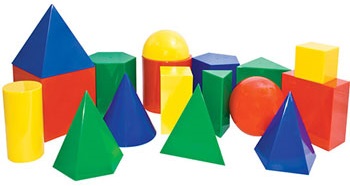The purpose of this activity is to support students using naming common two-dimensional shapes using mathematical terms. Students also explore where in real-life they encounter these shapes.
- A set of solid shapes, such as relational solids (pictured)

- Copymaster. This could be adapted to include objects that are of greater relevance to your students.
- Begin the lesson by allowing students to explore the set of solids.
What can you tell me about this set of blocks?
Do you know the mathematical names of the solids?
Students might identify the different shapes, including those that act as the faces of the solid shapes, but may not know the mathematical names. Shapes like the triangular prism, cylinder, and sphere are likely to less familiar than the cube and square based pyramid.
- Discuss what it means when we say that the shapes are three-dimensional (solid). Draw attention to the two dimensions of flat (planar) shapes like the square and circle: length, and width. A cube has an added dimension, height. You might illustrate that by comparing or building a square and a cube (e.g. using card, playdough, or Blu-Tack and toothpicks).
Show the students the pictures in the Copymaster.
For each picture I show you, I want you to find the matching shape in our set.
How do you know that you have chosen the matching shape?
What did you look for?
For example, show the picture of the drum and look for students to identify the cylinder as the matching shape.

- Students may need prompts to describe the shapes beyond global appearance, as in "they look the same.” To encourage more detailed descriptions, draw students’ attention to features like corners (vertices), edges, faces, and curved surfaces. Progress to property descriptions, such as “The cube has 6 square faces.” You might introduce relevant te reo Māori kupu such as tapa (side/edge), akitu (vertex), and mata (face).
- Use your discussion to make a list of the names, features, and property descriptions of the solid shapes.
Cube 8 corners 12 edges 6 faces that are squares Looks like a die (dice) | Sphere A 3-dimensional circle No corners, edges, or faces Looks like a netball |
- Ask students to choose two or three solids.
Draw (or create) an object you know that is that shape.
Make your drawing as clear as possible.
You might need to model drawing some of the solid shapes. Consider providing grid or isometric dot paper, or other building materials (e.g. playdough, Blu-Tack and toothpicks), or digital tools to aid students in creating their shape drawings. As a precursor to this, you might ask students to identify objects in your immediate environment that match the given shapes.
- Provide time for students to share their shape drawings with their peers. As they share, ask the remaining students to find the matching shapes. Ask them to explain their choice by referring to the properties of the solid and matching those properties to the object.
For example, “this is an orange, and it is shaped like a sphere. Anyway you look at an orange it is round like a circle.”
Next steps
- Start with a single 3-dimensional shape. Focus on similarity and difference.
- Find a shape that is the same as this one in some way.
Note that the similarity might be:- faces that are the same shape such as a cone and cylinder or cube and square-based pyramid
- curved surfaces such as a cylinder and a cone
- an apex such as a cone and a pyramid
- Find a shape that is different to this shape in some way.
Look for students to explain the difference by attending to properties, such as “this shape has triangles for faces and this shape has squares” or "the shape is curved and this shape is not".
- Find a shape that is the same as this one in some way.
- Look for 3-dimensional shapes in the environment. Go on shape hunts around the school or ask students to use digital technology to find images that contain 3-dimensional shapes. Make connections between shapes and purpose. For example, “rectangular prisms make good boxes because they stack,” or “spheres make good sport balls because they roll and bounce smoothly.” Discuss features and purpose with questions like, “how are a cylinder, cone, and sphere different in the way they roll?” and “why are cans the shape of cylinders?”